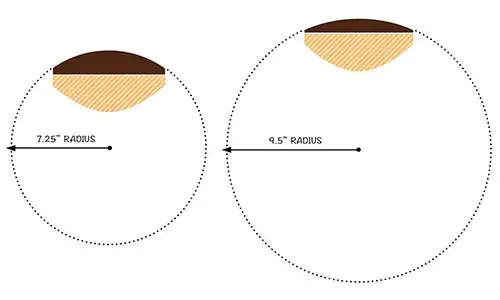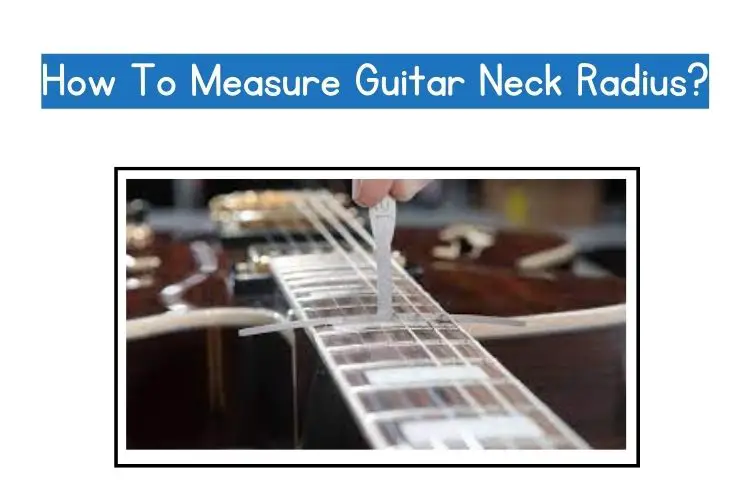Table of Contents
What Is A Guitar Neck Radius?
If you have held a guitar before or even if you have seen one in pictures, you probably would’ve noticed the long elongated neck of the guitar. That’s called the fretboard or the neck of the guitar.
The phrase “neck shape” might refer to the guitar’s back form, neck profile, or the cross-section where the neck and back meet.
A curved guitar neck helps you play better. It gives a more natural feel while playing barre chords, as our finger is curved as well.
At the same time, flat fretboards help you play the fingerstyle more easily and help you in bending the chords easily and smoothly.
Now, if you look down the neck of the guitar, you’ll see that sometimes it’s curved. The neck radius determines that curve. Is it good? Is it bad? And how do we measure the radius of a guitar neck? Well, let me answer all of your queries.
What Is The Meaning Of Radius?
As simply as I can put it, the higher the number, the flatter the fretboard will be, and the smaller the number, you will see curvature in the shape of the fretboard.
How To Measure A Fretboard?
There is a little arch among the high and low E strings on your guitar’s neck, which you can see if you look closely.
This arch is known as the radius by the manufacturers. Imagine that the curve of the fretboard is a section of a huge circle, as depicted below, to help you picture this.
Your fretboard would follow the same arc if the hypothetical circle had a 7.25 or 9.5 inches radius.

Types of Guitar Necks:
There are 3 very basic guitar neck types. They are named after their shapes, such as V neck, C neck, and U neck. These shapes being the most basic types of guitar neck shapes, there are 6 shapes in total, as listed below:
- U shape
- Oval C shape
- Soft V shape
- Medium V shape
- Hard V shape
- Modern Flat Oval
Let’s discuss these types in detail so that you can understand which guitar shape is the best for you.
U shape
A u-shape also referred to as a “baseball bat neck,” is frequently observed on thicker guitar necks. They are useful for guitarists with large hands, those who play with their thumbs on the side or back of the neck, and those who do so.
Pros and Cons:
Either the u-shaped neck is well balanced, or one side is thicker than the other. This feature is helpful for customization because players can choose their preferred thickness.
The fact that they feel more substantial and are less likely to deform from extremes of heat or cold over time is another reason consumers like broad necks.
One disadvantage of a u-shaped neck is that it is challenging for players with little hands. Average-sized and smaller players frequently find it uncomfortable to play the guitar with a baseball bat neck.
Examples:
- MH-400
- ESP LTD TL-6
- Gretsch G5021E Rancher Penguin Parlor
- ESP LTD EC-10
- ESP LTD Xtone PS-1
Oval C Shape
The oval c-shaped guitar neck is comfortable for all playing styles unless you have gigantic hands. It’s practically flat and comfortable to play on.
The c-shape is the most common kind of guitar neck shape. It’s practically flat and comfortable to play on.
Some guitar models, such as those produced by Fender, may have a flatter c-shape than others. The overall shape is the same, though.
There are many possibilities for various players, which is perhaps the nicest feature of this neck design. There are numerous variations of oval c-shape necks, including:
- Slim
- Extra-slim
- Fat
- Nut-shaped
- Huge
Pros and Cons:
The c shape is popular among players since it is typically rounded, thin, and narrow. You could enjoy the sensation of your thumb floating freely, as opposed to being in contact with the wood of the guitar neck.
Some people believe that playing faster is aided by the thinness, which makes the hand more mobile.
Although some contend that narrower necks are more prone to warping than thicker necks, having a narrow neck might help you move more quickly.
Long-term durability is decreased, especially if you mistreat your instrument while playing. With each season change, the wood also needs more frequent upkeep and modifications.
Examples:
- Ibanez AZS2200F-STB Prestige
- Guild M-20 Concert
- Harley Benton SC-500 BK Vintage Series
Soft V
The soft v provides your thumb enough room to play melodies on top around the neck’s midsection. The soft v-shaped necks, which essentially have no v at the nut, make playing enjoyable. It is sometimes known as a compromise v.
V-shaped necklines are viewed as being outdated in general. They are typical of vintage guitars. However, many players may find the soft variety to be the most comfortable.
Examples:
- Gibson ’50s LG-2
- Beard Guitars Deco Sidecar 137
- Furch Red Masters Choice Gc-SR
Medium V
Another type of v-shaped guitar neck is the medium v, which is neither as sharp nor as rounded as a hard v. The medium v is a traditional form for guitar necks. Both old and new models frequently still have them.
Like other v-shapes, the medium v-guitar neck shape is best suited for guitarists who are at ease placing their thumbs over the fingerboard’s edge. However, only use this form if you want a faint twang in your tone.
Example:
- 1956 Stratocaster
- Jerry Donahue Tele
Hard V
Only thumbs-over players should use a firm v-neck, commonly known as an “extreme v.” In guitars made to order, a hard v could be visible.
Only versions of old and reissued guitars come in a hard v shape. Today’s models don’t use it very much.
Because they can provide a greater tone than thin necks, thicker, chunkier necks are popular because of this. However, a lot of individuals claim that it is subjective. Overall, the distinction between a soft and firm v shape is minimal.
Examples:
- Fender EOB Ed O’Brien Stratocaster
- Eric Clapton Replica Stratocasters
Modern Flat Oval
Also known as a D-shape neck guitar is a more contemporary and shallow design. This neck type is common on guitars made to order in the HM style, and the radius is often flatter.
The major drawback of a modern flat oval guitar neck form is that some individuals don’t like how flat it feels. Some Jazz Guitarists contend that it is challenging for their thumb to intuitively locate the neck’s center.
Some players may experience hand fatigue more quickly from flat or shallow forms.
Examples:
- Ibanez JP20
- Ibanez GB10
- Epiphone Sheraton II
- Epiphone Les Paul Standard
How To Measure A Guitar Neck Radius Without A Tool?
You can cut out circles with different radii. Place the fingerboard inside a circle with a different radius to see what a different size fingerboard radius looks like.
Since the fingerboard’s width is constant, the larger circle produces a flatter arc over the fingerboard.
The typical fretboard radius measurements are 9.5″, 10″, and 12″. The fingerboard is flatter the higher the number.
The fingerboard radius is completely subjective from the viewpoint of a guitarist and has to do with feel and playability; there is no better or worse radius. Your choice will rely on what suits your playing style and hand.
When the fingerboard radius is rounder, it tends to fit your fingers’ natural, relaxed curve, making it much simpler to play at lower neck positions, chords, and barre chords wherever on the neck.
A flatter radius creates a more even and continuous playing surface for vertical fingerboard movement and string bending, especially at higher positions.
Measuring guitar neck radius with the help of tools
Radius Gauge:
A fretboard or fingerboard radius gauge is another name for a guitar radius gauge.
To ensure that the fretboard radius matches the string configuration, they are employed during the fretboard manufacturing process or even if you want to measure the radius of your guitar.
This ensures that the instrument is configured to generate the desired sound and that the musician is as comfortable as possible.
Under string guitar radius gauge
The strings are set up with an under-string radius gauge to match the fretboard on your guitar. The guitar you are working on, its make, and its model will determine the string spacing.
Homemade fretboard radius gauges
You can print and cut out a fretboard template that is available for download. You can also create your cut-out template by drawing it yourself.
Pros and Cons of Radius Gauge:
- Pros: A guitar radius gauge’s benefit is that it enables a quick visual examination of the fretboard. It prevents you from making the simple, difficult-to-correct error of unintentionally changing the form. There are gauges for every price range because many different materials may be used to make guitar radius gauges.
- Cons: The limitation of a guitar radius gauge to fingerboard applications makes it a drawback. The durability or accuracy of homemade guitar radius gauges may be inferior to commercially available models.
Steps of how to use a Radius Gauge:
- Look for the guitar radius gauge that corresponds to your neck’s radius (or arc). If you’re not sure which radius gauge to use, test a few before choosing the one that most closely matches the arc of your fretboard. Radius gauges are typically sold in sets.
- The elevation of the upper and bottom E strings should be measured using a ruler that is graduated in 32nds or 64ths of an inch. The height of these strings should first be adjusted to your preferred action height.
- Place the gauge close to the bridge on top of the strings. Increase or decrease the height of the four inner strings until they touch the radius gauge because the high and low E strings have already been changed.
Different Guitars and their Radii
Over the years, various fretboard radii have been used on electric and acoustic guitars. Despite all the differences, there are a few mutual fretboard radii based on the type of instrument.
Electric Guitar Fretboard Radius:
First, there are many more electric guitar manufacturers than acoustic guitars, making them arguably more popular. Naturally, there will be more variety in all the specifications, including the fretboard radius, as there are many producers.
The second is that many electric musicians expect more out of their gear. Now, I’m not saying there aren’t many incredible acoustic musicians out there.
No, not at all! But let’s face it—many electric guitar players have significantly stretched the instrument’s capabilities over the past few decades.
As a result, some musicians will adjust every single detail on their instruments to maximize performance. The radius of the fretboard is the same.
Furthermore, the electric guitar is a relatively young invention compared to many other stringed instruments.
Since electric guitars are relatively new, players and manufacturers are less constrained by tradition than with other instruments. Since its inception, the electric guitar has served as a testing ground for numerous developments!
So here’s a list of the common fretboard radii found in a few major electric guitar manufacturers.
- Danelectro, 14″
- Epiphone, 12″
- Fender (vintage), 7.25″
- Fender (Modern), 9.5″
- Gibson, 12″
- Gretch, 9.5″ – 12″
- Jackson, 16″
- PRS, 10″
Acoustic Guitar Fretboard Radius:
The variety of Acoustic guitars is not quite as great as that in electrics. Except for Ovation, most acoustics feature fretboards that are flatter than the electric guitars and between 12 and 16 inches long.
Some models, particularly trademark versions, depart from these parameters, just as with electric guitar manufacturers.
There are also some vintage steel-string guitars with flat fretboards with no radius. Although they are uncommon, you occasionally run into one if you’re around guitars a lot.
How To Measure Bass Guitar Neck Radius?
On electric bases, you will also notice variances in the radius of the fingerboard. The majority of basses have radii that are comparable to those of electric guitars.
For instance, the fretboard radius on the majority of Fender/Squire basses will either be 7.25′′ or 9.5′′. On the other side, Gibson/Epiphone almost invariably has a 12′′ radius. The majority of
Other manufacturers will also fall between 10′′ and 16′′.
Let’s highlight one thing regarding basses right now. Bass players don’t seem to be as particular about fretboard radius as guitarists, even though it is vital for basses.
There are certainly players out there that favor a rounder or flatter board. However, a lot of other players don’t care about the fretboard radius.
This, in my opinion, has a lot to do with how the guitar and bass are played differently.
When you’re playing a lot of chords, breaking land speed records, or attempting a lot of bends and other fretboard gymnastics, the radius of your fretboard becomes increasingly important.
Pros and Cons of a curved Fretboard:
Pros:
A fretboard with a smaller radius or a more curved shape feels great to many players. For chord playing and the majority of other playings in general, a more arched fretboard feels excellent in your hand.
The tighter curve is more in line with the organic shape of your fretting hand while you play.
Playing on a board with more curves is more ergonomic and comfortable overall. This is especially apparent when playing chords or stretching out farther.
Cons:
If you frequently bend strings and prefer a super-low action, you may experience issues with fretboards that have a greater degree of curve.
As you bend the strings towards the middle of the neck, they occasionally tend to choke out or fret out on a tighter fretboard.
You see, when a string is bent towards the middle of the neck, the vibrating portion of the string may contact the fretboard’s middle hump and choke out. If the guitar has low initial action, this is accentuated even further.
Because there is less of a hump in the center of the fingerboard for the string to run into, fretting out is less of a problem on a flatter fretboard.
Pros and Cons of a curved Fretboard:
Pros:
Flatter fretboards are perfect if you frequently bend strings or have an extremely low action on your guitar.
When you don’t have to dread the guitar fretting out on a strong bend, a flatter board and lower action may make solos and all kinds of fretboard gymnastics that much easier.
Because of this, a lot of lead guitarists, especially shredders, favor fretboards with a greater, flatter radius.
Cons:
Although flat fingerboards are excellent for lead work, they are not as ergonomically or comfortably designed as a more curved board.
While playing leads and bends is simple, you’ll suffer for it when playing chords deeper down the neck.
What is a Compound Radius Fretboards:
A compound radius fretboard gradually flattens to a bigger radius higher up the neck from a tighter radius at the nut.
Just Imagine a fretboard with a compound radius that might have a 10′′ radius at the nut and progressively flatten out to a 12′′ radius at the base of the neck.
Fundamentally, a fretboard with a compound radius is curved like a very gradual cone from one end to the other, even though it’s very subtle; it is there.
A fretboard with a compound radius indeed gives you the best of both worlds. Lower down the neck, where the radius is narrower and feels fantastic for chords.
You have a flatter radius higher up the neck for all your bends and other lead guitar antics.
What Type Of Fretboard Is The Best For You?
As with most queries about musical instruments, the answer depends. As I previously stated, most players prefer a board with a narrower radius for chords while preferring a flatter board for leads.
The majority of players agree on this, although there are many instances where that is not the case.
Some players prefer a flatter board for all of their playings rather than simply leads. Even for chords, they believe a flatter fretboard to be more pleasant.
On the other hand, some excellent lead players and shredders favor a fretboard with a smaller radius.
I hope this clears out all of your questions. Best of luck with choosing the perfect guitar for you.



![HERE’S What Happened to the Soul Singer Al Green [2023 Update]](https://performerlife.com/wp-content/uploads/2023/04/what-happened-to-al-green-211x150.jpg)
